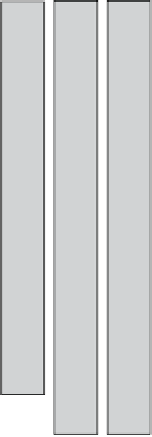Geology Reference
In-Depth Information
Table 8.2
Cation co-ordination in silicates
Cation
Radius ratio
Predicted
co-ordination
Occurrence in minerals
Si
4+
0.26
4-fold
(tetrahedral)
Z-site
{
al
3+
0.36
0.46
ti
4+
0.52
6-fold
(octahedral)
site
Fe
3+
0.55
Mn
2+
0.56
Mg
2+
0.61
Fe
2+
0.65
Ca
2+
0.91
8-fold site
Na
+
0.94
K
+
1.27
≥ 12-fold site
Of every four tetrahedra in the amphibole structure,
two share two oxygens and the other two share three
oxygens (
p
= 1.5). In principle this leads to the formula
Si
4
O
11
or Si
8
O
22
, as in tremolite (Ca
2
Mg
5
Si
8
O
22
(OH)
2
).
However, some of the tetrahedral sites may contain Al
in place of Si (the ionic radius of aluminium is just small
enough to admit it to tetrahedral as well as octahedral
sites - Table 8.2). This will of course alter the Si:O
ratio in the amphibole formula, as in pargasite
(NaCa
2
Mg
4
Al [Al
2
Si
6
O
22
] (OH)
2
). Square brackets are
used here to distinguish Al in tetrahedral sites (inside
the brackets) from the remaining Al occupying octa-
hedral sites. Notice that both of these examples conform
to a more general formula Z
8
O
22
, where 'Z' includes
both silicon and 'tetrahedral aluminium' (Box 8.5).
Because of its different valency, the substitution of Al for
Si requires an adjustment among other cations present
(discussed later) in order to maintain electrical neutral-
ity. A similar substitution occurs in some pyroxenes.
the micas - like biotite and muscovite - and a variety of
other sheet silicates. All of them are
hydrous
, with OH
−
or other anions occupying the rings, and like amphi-
boles they
dehydrate
at high temperatures (Figure 2.3).
Sheet silicates can be recognized chemically by hav-
ing Z
4
O
10
in the formula (Table 8.1). The varieties of
sheet silicate - micas, chlorite, clay minerals (Box. 8.2),
serpentine, etc. - can be regarded as multilayer sand-
wiches, differing from each other in the identity of the
ionic 'filling' and the manner in which sandwiches are
stacked together. As in many sandwiches, the bread (the
silicate sheet) is more coherent than the filling, so sheet
silicates have a marked platy cleavage, as developed
most obviously in micas like muscovite and biotite.
Framework silicates
Finally we come to a class of silicates in which every
oxygen atom is shared between two tetrahedra, extend-
ing a semi-covalent network in all directions through
the crystal. Because the volume of the crystal is deter-
mined wholly by the sp
3
-based 'covalent' framework
and not by the packing together of ions and separate
SiO
4
polymers, such
framework silicates
usually have
lower densities than other types of silicate (often less
than 2.6 kg dm
−3
). The structures of some incorporate
Sheet silicates
When every (Si,Al)O
4
tetrahedron shares three oxygen
atoms with neighbouring tetrahedra (
p
= 1), a continu-
ous covalently bonded sheet structure is formed
(Figure 8.3c) which provides the basic framework for







































Search WWH ::

Custom Search